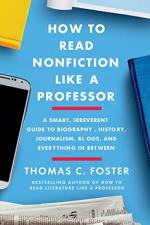
|
| Name: _________________________ | Period: ___________________ |
This quiz consists of 5 multiple choice and 5 short answer questions through Section 3: Chapter 9, "Living the News" through Chapter 12, "That Is So Last Year".
Multiple Choice Questions
1. In Chapter 7, "All in How You Look at Things," what does Foster say is the purpose of the academic five-paragraph essay?
(a) It is the most that students are capable of before college.
(b) It is the preferred format for professional writing.
(c) It teaches students to organize their thoughts.
(d) It is a flexible and useful format for anything a student might need to write about.
2. In Chapter 10, "From the Inside Out," which claim does Foster make about thesis statements?
(a) It does not need to limit the content of the essay.
(b) A thesis can be placed anywhere in an essay.
(c) No one can truly come up with a "unique" thesis.
(d) An implied thesis is more sophisticated than a directly stated thesis.
3. What is being discussed in Chapter 10, "From the Inside Out," when Foster says that the "form and tone of the essay must fit the writer like a suit" (144)?
(a) Subjectivity and attachment.
(b) Conflict and theme.
(c) Characterization and personality.
(d) Style and voice.
4. In Chapter 11, "Life from the Inside," Foster discusses the use of parallelism. He is discussing what technique?
(a) The repetition of grammatical structures.
(b) The exact repetition of words and phrases.
(c) The use of tone that mimics the subject under discussion.
(d) The use of multiple, similar examples.
5. In Chapter 9, "Living the News," how does Foster apply the idea of "free indirect speech" to New Journalism?
(a) He uses it to compare New Journalism with immersive journalism.
(b) He uses it to contrast New Journalism with fiction.
(c) He uses it to explain how Thompson narrates his own thoughts.
(d) He uses it to label Wolfe's attempt to recreate the inner lives of his subjects.
Short Answer Questions
1. In Chapter 2, "The Ecology of the Nonfiction Biosphere," what problem does Foster say can arise if readers do not understand the forms of writing?
2. In Chapter 10, "From the Inside Out," why does Foster not capitalize the name of bell hooks?
3. In Chapter 7, "All in How You Look at Things," what does Foster cite as one of the main reasons that Americans have historically trusted the news media?
4. In Chapter 7, "All in How You Look at Things," Foster says that which type of nonfiction is usually better off starting at the beginning chronologically?
5. In Chapter 4, "The Parts You Don't Read," what is a piece of information that Foster says we can infer from the notes?
|
This section contains 484 words (approx. 2 pages at 300 words per page) |

|




